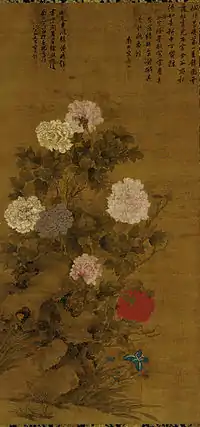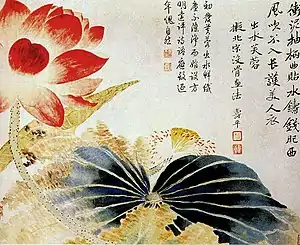Yun Shouping
Yun Shouping (惲壽平), also known as Nantian (南田) (1633 – 1690), was a Chinese calligrapher and painter. He was a major artist of the early Chinese Qing dynasty. He was regarded as one of the "Six Masters" of the Qing period, together with the Four Wangs and Wú Lì.

Biography
Yun was born to a prominent but impoverished family in Wujin, Jiangsu province. He excelled in his classes and was expected to enter into the civil service, but his family could not afford it. Instead, he devoted himself to art; as early as the age of eight he was composing poetry on lotus blossoms. In his early life, he made a living painting landscapes.
As a young man, once he had the means, Yun traveled China and became acquainted with the art of Wang Hui and Zha Shibiao. On seeing Wang Hui's landscapes for the first time, Yun felt overawed and gasped, saying "In this art, your learning and talent surpass all. Try as I may, I can only rank second."[1] Unwilling to rank second, Yun shifted his focus; he studied flowers, birds, insects, and bamboo. Yun imitated the 11th century artist Xu Xi's mogu (or 'boneless') method, an approach that tried to express art without rigidly defined outlines and forms. This style became a hallmark of the Yun family's artistic style, with Yun's daughter Bing continuing to develop the technique.[2]
Yun's style was vibrant and expressive; he attempted to display the inner vitality and spirit of his subjects in painting. Yun sought inspiration from the past; his Flower and Fruit (now at the Hong Kong Museum of Art) imitated the style of the masters of the Yuan dynasty. He was unafraid of using strong colors, such as reds and purples, which had traditionally been shunned by Chinese painters as they were seen as gaudy and offensive. He revived the genre of flower paintings in China and became popular throughout the country. Yun's style would be imitated and he became the founder of the Ch'ang-chou school of painting. Yun was also recognized as a prominent calligrapher, in which he followed the style of Chu Suiliang.
Works
| Wikimedia Commons has media related to Yun Shouping. |
 Yun Shouping, Lotus Flower Breaking the Surface (出水芙蓉圖), Palace Museum, Beijing
Yun Shouping, Lotus Flower Breaking the Surface (出水芙蓉圖), Palace Museum, Beijing Yun Shouping, Magnolias
Yun Shouping, Magnolias Yun Shouping, Peonies
Yun Shouping, Peonies Yun Shouping, Old Trees and Bamboo
Yun Shouping, Old Trees and Bamboo.jpg.webp) Yun Shouping, Sunset along Floral Embankment (花隝夕陽圖), Kyoto National Museum
Yun Shouping, Sunset along Floral Embankment (花隝夕陽圖), Kyoto National Museum
References
- "Peonies". web.archive.org. Archived from the original on 20 August 2003. Retrieved 11 May 2020.
- Lu Haiyang 路海洋 (2013), "毗陵望族恽氏家族文化成就考述" [Discussion of the achievements of the influential family near the mound, the Yun clan], Changzhou Gong Xueyuan Xuebao (Shekeban) (in Chinese), 31 (1): 1–7
External links
- Landscapes Clear and Radiant: The Art of Wang Hui (1632-1717), an exhibition catalog from The Metropolitan Museum of Art (fully available online as PDF), which contains material on Yun Shouping (see index)
- Flower and Fruit, now at the Hong Kong Museum of Art
- Peonies at the National Palace Museum of Taiwan
- Peonies at the Smithsonian